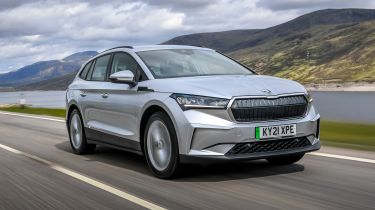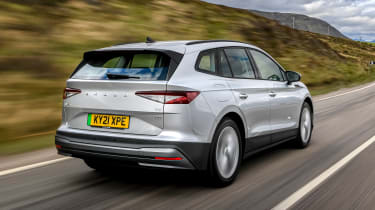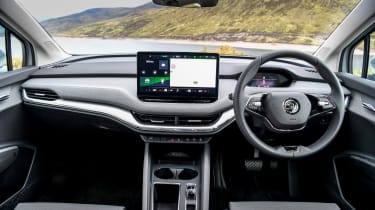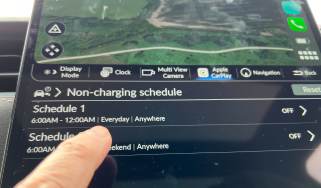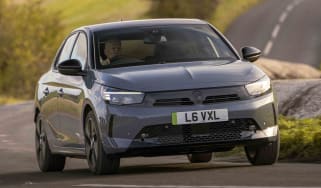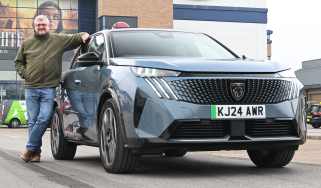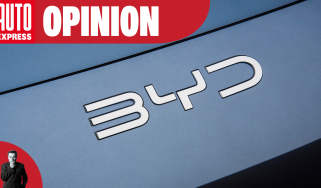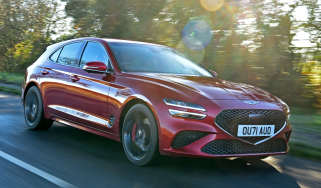New Skoda Enyaq iV 2021 review
The new Skoda Enyaq iV is the Czech firm’s first bespoke electric car and we've tested the full range on UK roads

Verdict
Our taste of the entire Skoda Enyaq iV model range in right-hand-drive form has reinforced our opinions from our drive in an early European car. The Enyaq is an excellent EV, offering the space, practicality and refinement Skoda has become known for, but with some big tech advances too. It’s high quality, rides and handles well, and although it could offer more performance, it’s adequate in that regard. Range is respectable even if improved recharge capability is an option, but it’s how Skoda has packaged all of the car’s talents in an easy-to-use package that is the big appeal here. It’s an EV done the Skoda way.
Driving across the Scottish Highlands is about as tough a test as you can get for an EV. Miles of punishing, winter-ravaged tarmac puts the spotlight on ride comfort and handling, but with settlements few and far between and the charging infrastructure not quite as advanced as elsewhere in the UK (to put it mildly), range is a key issue as well.
But the Skoda Enyaq iV took all of this in its stride on our test, proving that it’s an excellent all-electric family SUV.
Let’s recap first. Skoda’s first bespoke electric car is available with two different battery sizes, called the Enyaq iV 60 and the Enyaq iV 80.
The former features a 58kWh (usable) battery for a range of up to 256 miles, while the latter offers 77kWh of usable energy and a maximum certified cruising range on a full charge of 333 miles.
Used - available now

2022 Skoda
Enyaq
30,906 milesAutomaticElectric
Cash £22,300
2022 Skoda
Enyaq
19,243 milesAutomaticElectric
Cash £18,600
2023 Skoda
Enyaq
13,557 milesAutomaticElectric
Cash £18,800
2022 Skoda
Enyaq
44,806 milesAutomaticElectric
Cash £16,800The smaller battery model boasts a 177bhp rear-mounted electric motor, while the 80 features a 201bhp drive unit powering the rear wheels.
The Enyaq 60’s performance feels adequate, helped by the fact that it makes the same 310Nm of torque as the 80 model. It’s this that gives the car its characteristic relaxing feel, because the torque is available from low speed and sustained up to motorway velocities. This fairly strong surge helps you get up to speed swiftly, if not as rapidly as we’ve come to expect in some EVs.
This feels like a conscious decision from Skoda though, with the throttle pedal’s map programmed to smoothly deliver the power and torque in both battery variants.
The two cars are only separated by two tenths of a second when it comes to the 0-62mph times, the more powerful 80 car taking 8.2 seconds for the benchmark sprint. With a kerbweight of around two tonnes for both variants, it’s no surprise.
However, the Enyaq hides its weight relatively well. That’s because the battery is mounted low down in the floor, keeping the car’s centre of gravity relatively low for an SUV. In fact, it handles even better than Skoda’s Karoq and Kodiaq SUVs, with more positive steering and less roll.
Carrying around this extra kerbweight – most of it accounted for by the battery – often means an EV’s ride comfort can be affected. We tried both the standard passive suspension set-up, and Skoda’s Dynamic Chassis Control adaptive damper option, and the former on 20-inch wheels is all you need.
There is the occasional big thump that sees the Enyaq shift sideways across the road slightly, where the weight really does become apparent, but otherwise the body control at higher speeds on twisty roads is surprisingly good and the ride isn’t far behind it. Yet the car still retains a degree of floatiness over undulations to deliver the comfort you expect from a family-focused machine like this.
Our Sportline test car was fitted with the optional £585 Drive Sport Package Plus, which adds adaptive dampers. On 20-inch alloys it felt softer than the standard set-up at the most comfortable end of the scale, and firmer at the other end to tie the Enyaq down just a little bit better.
However, the difference in comfort isn’t that great, and this, rather than driving flat-out, is what the car is focused on - even though there is some enjoyment to be had. As a result, we’d do without the adaptive dampers.
This driving style also is at odds with the Enyaq’s approach to efficiency and means you’ll have to charge more frequently, which is where one downside does come in.
Standard rapid charging capability stands at 50kW, but for £440 on the 60 version you can upgrade this to 100kW, with a rapid charge from 0-80 per cent taking 35 minutes. For the same money on the iV 80 the upgrade adds 125kW capability, so on this bigger battery model the faster charging rate means the same top-up takes 38 minutes.
On the 80 a full charge from a 7.2kW wallbox takes 13 hours, which is more than likely how most owners will recharge, while intelligent and nicely calibrated regenerative braking means you’ll recoup energy on the move too. We’d like a stronger setting on the re-gen bakes above the Enyaq’s maximum to allow true one-pedal driving, this would boost the already relaxing and refined driving experience even further.
The biggest positive when it comes to range and recharging is that you can trust the Enyaq’s predictions, though. Drive without too many concessions to efficiency and you’ll only use one mile of indicated range every one mile you travel, unless you’re on the motorway at higher speed. Take the range claims with a pinch of salt though; you won’t get near the official 333 miles from the iV 80 (327 miles in Sportline models), but 280 in warm conditions should be possible.
No matter which model you choose, this predictability makes it a practical, usable car, which is what Skoda knows how to do best – and the Enyaq’s packaging backs this up.
With the Enyaq based on the VW Group MEB platform for electric cars, room inside is excellent. It feels very spacious, with plenty of head and legroom in the rear – more so than a conventional, similarly sized SUV, we’d say.
Add in a fair 585-litre boot and it highlights that Skoda hasn’t tried to rip up the rule book and reimagine itself in its transition to all-electric motoring. Instead, this EV is recognisably a Skoda, offering all the pragmatism you expect, just with a different and exceptionally refined powertrain.
Prices start from £31,995 as all iV 60 models qualify for the £2,500 government plug-in car grant. However, go for the iV 80 and you’ll be looking at a starting price of £39,350, rising to £42,900 for the Sportline model in our pictures.
This is where the Enyaq breaks new ground for the brand, as higher trim levels are pricey, even if the leather-lined cabins of the top models do feel nicely premium, high quality and boast plenty of tech, including the biggest infotainment screen ever fitted to a Skoda, at 13 inches.
It works well, is packed with features and, along with the digital dash, provides plenty of crisp, clear information. All models feature this tech, with sat-nav, Apple CarPlay and Android Auto, LED headlights, lane assist, autonomous emergency braking with collision warning, cruise and dual-zone climate control, parking sensors and alloy wheels.
Skoda is also trying to simplify the buying process, as you choose your Enyaq on its interior design specification, with Loft, Suite, Lounge and EcoSuite themes. Sportline adds more supportive sports seats, a chunkier bodykit and black exterior styling extras, while you can also add key options as part of the packs.
| Model: | Skoda Enyaq iV 80 Sportline |
| Price: | £42,900 |
| Battery/drive: | 77kWh (usable)/single electric motor |
| Power/torque: | 201bhp/310Nm |
| Transmission: | Single-speed automatic, rear-wheel drive |
| 0-62mph: | 8.2 seconds |
| Top speed: | 99mph |
| Range: | 327 miles |
| Charging time: | 0-80% in 38 mins (£440 125kW option) |
| On sale | Now |

